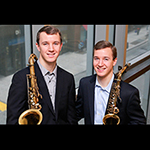Sondheim on Sondheim
Phoenix Theatre Company, Phoenix, AZ, February 28, 2020
Reviewed by Lynn Timmons Edwards

Phoenix Theatre Company (PT) is celebrating its 100th year, having evolved from a community playhouse in 1920 to a significant regional theater complex employing professional actors and creating new works for the American theater. For Sondheim on Sondheim, the Hardes Theatre was transformed into a “rectangular” theater in the round with the audience members facing each other on two sides. All of the cabaret shows this reviewer has seen there had been performed in the traditional proscenium style, so the change was exciting. The set incorporated a bar, which served drinks before the show and at intermission, a few movable pieces of furniture, a small staircase opposite the bar creating the only elevation, and for some reason an upright piano that was never played. Conductor and pianist Steve Hilderbrand was projected on small screens visible to the actors and audience, as he led the six-piece orchestra off-stage.
Conceived by long-time Sondheim collaborator James Lapine, the revue had a limited Broadway run in 2010 and has been performed sporadically at theaters since. Director Robert Kolby Harper opted for a cast of six superbly talented singers roughly divided into three couples of super young, young, and slightly more mature. The show itself is a hybrid of documentary footage of Sondheim talking about his life and work, interspersed with mostly mash ups of his songs. Because he writes so specifically for character and story, the medleys, while beautifully harmonized, often come off as frenetic or emotionally distant. Sondheim is funny, crusty, and full of gossip about Broadway, especially the triumphs and failures of his own shows, his troubled relationship with his mother, and his affection for his mentor and surrogate father, Oscar Hammerstein II.
I entered the theater as a huge Sondheim fan and left still loving the material that I knew. But I was underwhelmed by the cut material and songs from shows that flopped. The best moments came when the performers had the chance to solo or perform whole scenes or songs. There are no spoken words from anyone other than Sondheim. The original 64 plasma screens from Broadway were reduced to six small television screens, and the staging, while often clever and always fluid, required that no audience member looks into the eyes of the singer for an entire song.
Rusty Ferracane, a veteran of 27 productions at Phoenix Theatre alone, was the singer most able to deliver the music and lyrics across the footlights. His baritone voice soared, and he connected with the audience, especially as Sweeny Todd in “Epiphany.” Two of the cast members, Kathlynn Rodin and Brandon Brown are both triple-threat juniors in college, which demonstrates PT’s commitment to developing young professional talent. They were perfect as the young struggling writers in Merrily We Roll Along. Ferracane was hysterical as the cigar smoking producer joining the trio in “Opening Doors.” Rodin delivered a lyrically poignant “Do I Hear a Waltz?,” despite Sondheim’s commentary that the show, written with Richard Rodgers was a “why do it” musical, which he did for all the wrong reasons. Merissa Haddad had to have been cast just for the tour-de-force “Ah, But Underneath,” a song Sondheim wrote for Diana Rigg for the London revival of Follies. She was sultry and moved her extremely thin frame across the stage like a scarlet work of art. Jonathan Hoover’s best solo, “Finishing the Hat,” could have used a little more projection, but he was a believable and intense George. I also loved his duet with Brown, “The Best Thing That Ever Happened” from Roadshow rewritten as a love song for two men.
Sondheim wrote an original song for this revue, “God,” which opens Act II. It was inspired by a New York Magazine article, “Is Sondheim God?” There was a projection, but it wasn’t large, and I thought it said, “Is Sondheim Gone?” I found it one of the best numbers in the show and now I get it. Halliday was funny in her duet with Ferracane, “You Could Drive a Person Crazy” and stunning with her “Send in the Clowns,” even though I was looking at her from the back sometimes. She also moved me with “Not a Day Goes By,” deliciously arranged to counter Haddad’s “Losing My Mind.”
I longed for songs that were omitted. We got three endings to Company, but not my favorite, “Marry Me a Little.” The full company did a rich “Children Will Listen” as commentary on Sondheim’s childhood; but not “No One is Alone,” a song we need these days.
Is Sondheim on Sondheim better than a well-conceived cabaret show of his music? No. In order to have “wow factor” audience impact do you need much more elaborate technology? Yes. Should the cast and artistic team be applauded for producing the work in Arizona? Absolutely. Tickets are selling fast for the run which closes April 5.





